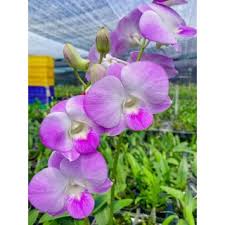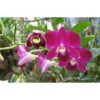# Exploring Eco-Friendly Materials for Growing Dendrobium Orchids

Dendrobium orchids, renowned for their stunning blooms and diverse species, are a favorite among plant enthusiasts. As interest in sustainable gardening practices grows, many orchid lovers are exploring eco-friendly materials for cultivating these beautiful plants. Using sustainable growing mediums not only benefits the environment but also promotes healthier plant growth. This article will delve into various eco-friendly materials suitable for growing Dendrobium orchids, their benefits, and how to utilize them effectively.
## 1. Understanding Dendrobium Orchids
Before diving into the materials, it’s essential to understand the specific needs of Dendrobium orchids. These orchids are epiphytes, meaning they typically grow on other plants rather than in soil. They thrive in environments that mimic their natural habitat, which includes:
– **Good drainage**: Dendrobiums require well-draining media to prevent root rot.
– **Aeration**: Their roots need access to air to function properly.
– **Moisture retention**: While they need good drainage, they also benefit from materials that can hold some moisture.
With these needs in mind, let’s explore various eco-friendly materials that can be used for growing Dendrobium orchids.
## 2. Coconut Coir
### 2.1 What is Coconut Coir?
Coconut coir is a natural fiber extracted from the husk of coconuts. It is widely used in horticulture due to its excellent moisture retention and aeration properties.
### 2.2 Benefits of Coconut Coir
– **Sustainable**: Coir is a byproduct of the coconut industry, making it a renewable resource.
– **Biodegradable**: Unlike synthetic materials, coir decomposes over time, enriching the soil.
– **Moisture Retention**: It can hold moisture effectively while still allowing for good drainage.
### 2.3 How to Use Coconut Coir
Coconut coir can be used alone or mixed with other materials. To use it effectively for Dendrobium orchids:
– **Preparation**: Rinse coir to remove excess salts and let it dry before use.
– **Mixing**: Combine it with perlite or bark to improve aeration and drainage.
– **Application**: Use it as the primary medium in pots or baskets designed for orchids.
## 3. Bark
### 3.1 Types of Bark
Bark is a popular growing medium for orchids, especially Dendrobiums. Various types of bark can be used, including:
– **Pine Bark**: Often used for its excellent drainage and aeration properties.
– **Cypress Bark**: Known for its durability and resistance to decomposition.
### 3.2 Benefits of Bark
– **Natural Material**: Bark is a natural, biodegradable option that decomposes slowly.
– **Good Drainage**: Provides excellent aeration for orchid roots, reducing the risk of rot.
– **Microbial Life**: Supports beneficial microbes that can enhance plant health.
### 3.3 How to Use Bark
– **Preparation**: Use aged or chipped bark to ensure it is suitable for orchids.
– **Mixing**: Combine bark with coconut coir or perlite for better moisture retention.
– **Layering**: Place a layer of bark at the bottom of the pot for drainage, then fill the rest with your chosen mix.
## 4. Perlite
### 4.1 What is Perlite?
Perlite is a naturally occurring volcanic glass that expands when heated. It is commonly used in horticulture for its lightweight and aeration properties.
### 4.2 Benefits of Perlite
– **Lightweight**: Makes it easy to handle and transport.
– **Good Aeration**: Increases airflow to the roots, promoting healthy growth.
– **pH Neutral**: Does not alter the pH of the growing medium.
### 4.3 How to Use Perlite
– **Mixing**: Combine perlite with coconut coir or bark to create a balanced growing medium.
– **Application**: Fill pots with the mixture, ensuring that it allows for good drainage and aeration.
## 5. Sphagnum Moss
### 5.1 What is Sphagnum Moss?
Sphagnum moss is a type of moss that grows in wetland areas. It is often used in orchid cultivation for its moisture-retaining properties.
### 5.2 Benefits of Sphagnum Moss
– **Moisture Retention**: Holds water well, providing consistent moisture for Dendrobium roots.
– **Natural Insulator**: Helps regulate temperature around the roots.
– **Acidic pH**: Contributes to an acidic environment, which some orchids prefer.
### 5.3 How to Use Sphagnum Moss
– **Preparation**: Rinse sphagnum moss to remove any debris or contaminants.
– **Mixing**: Use it as a standalone medium or mix it with perlite or bark for added drainage.
– **Application**: Place a layer of sphagnum moss at the bottom of the pot for moisture retention, then add the rest of your mix.
## 6. Charcoal
### 6.1 What is Charcoal?
Charcoal, particularly horticultural charcoal, is a lightweight material made from burning organic materials in a low-oxygen environment.
### 6.2 Benefits of Charcoal
– **Absorption**: Charcoal absorbs excess moisture and toxins, helping to prevent root rot.
– **pH Neutral**: Does not affect the pH of the growing medium.
– **Air Spaces**: Creates air pockets in the mix, promoting aeration.
### 6.3 How to Use Charcoal
– **Preparation**: Use activated or horticultural charcoal, avoiding any that may contain additives.
– **Mixing**: Incorporate charcoal into your growing medium, using it in combination with bark or coir.
– **Application**: Add a layer of charcoal at the bottom of the pot or mix it throughout the medium.
## 7. Rice Hulls
### 7.1 What are Rice Hulls?
Rice hulls are the protective coverings of rice grains and are often considered waste material in rice production.
### 7.2 Benefits of Rice Hulls
– **Sustainable**: Made from a byproduct of rice farming, making them eco-friendly.
– **Lightweight**: Provides a lightweight option for growing mediums.
– **Good Drainage**: Promotes aeration and drainage in the growing medium.
### 7.3 How to Use Rice Hulls
– **Mixing**: Combine rice hulls with bark, coir, or perlite to improve drainage.
– **Application**: Use in pots or hanging baskets, ensuring that the mixture allows for good airflow.
## 8. Composted Organic Matter
### 8.1 What is Composted Organic Matter?
Composted organic matter refers to decomposed plant materials, which can provide nutrients to growing orchids.
### 8.2 Benefits of Composted Organic Matter
– **Nutrient-Rich**: Provides essential nutrients that promote healthy plant growth.
– **Improves Soil Structure**: Enhances the structure of the growing medium, improving moisture retention and drainage.
– **Eco-Friendly**: Reduces waste by recycling organic materials.
### 8.3 How to Use Composted Organic Matter
– **Preparation**: Ensure the compost is fully decomposed and free of contaminants.
– **Mixing**: Combine with bark or coir for a nutrient-rich growing medium.
– **Application**: Use in pots, ensuring that it is mixed well with other materials for proper drainage.
## 9. Other Considerations for Eco-Friendly Growing
In addition to using sustainable materials, consider the following practices for an eco-friendly approach to growing Dendrobium orchids:
### 9.1 Watering Practices
– **Rainwater Collection**: Collect rainwater for watering orchids to reduce tap water usage.
– **Water Conservation**: Water plants efficiently, allowing the medium to dry slightly between watering to prevent overwatering.
### 9.2 Fertilization
– **Organic Fertilizers**: Use organic fertilizers to provide essential nutrients while minimizing environmental impact.
– **Compost Tea**: Make compost tea from homemade compost for a nutrient boost without chemicals.
### 9.3 Pest Management
– **Natural Remedies**: Use natural pest control methods, such as neem oil or insecticidal soap, to manage pests without harming beneficial insects.
– **Companion Planting**: Incorporate companion plants that deter pests and promote healthy growth.
## 10. Conclusion
Growing Dendrobium orchids in eco-friendly materials is not only beneficial for the environment but also supports healthy plant growth. By utilizing sustainable options like coconut coir, bark, perlite, sphagnum moss, charcoal, rice hulls, and composted organic matter, orchid enthusiasts can create optimal growing conditions for these beautiful plants. Additionally, adopting sustainable gardening practices, such as efficient watering and organic fertilization, enhances the overall cultivation experience. As we embrace eco-friendly gardening methods, we can enjoy the beauty of Dendrobium orchids while contributing to a healthier planet. Happy growing!

